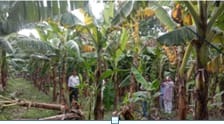Lucknow, 05 October (Hindus). Fusarium wilt disease caused by fungus is very harmful for banana crop. In case of severe infection the banana crop can be ruined. In recent years, its outbreak has been seen in many banana growing areas of Uttar Pradesh. Sohawal block of Ayodhya, known for banana cultivation, saw a widespread outbreak in 2021. Similarly, a serious outbreak of Fusarium Wilt Disease (TR4) was reported on banana crops in the major banana producing areas of the state like Maharajganj, Sant Kabir Nagar, Ambedkar Nagar and Kushinagar districts. Recent surveys have also confirmed widespread infection of the disease in Lakhimpur and Bahraich districts.
symptoms of disease
The infection of the disease occurs in the inner part of the banana stem. The inner part of the stem of the infected banana plant becomes brown or black instead of creamy in color.
Technology discovered by CISH to treat disease
The Central Institute of Subtropical Horticulture (CISH), Lucknow, affiliated with the Indian Council of Agricultural Research, and the Regional Research Centre, Lucknow, affiliated with the Central Salinity Research Institute, Karnal, together discovered its cure. With the patent being granted, farmers are now being encouraged to use it through the Agricultural Science Center, Ayodhya. The results have also been good. The farmers of Sohawal who had stopped or reduced banana sowing, now started sowing banana again.
It is noteworthy that under the leadership of Dr. T. Damodaran, a management protocol was developed using bioagent, ICAR Fusicont (Trichoderma based formulation) and bio-inoculation of tissue culture plants for prevention of the disease. The product Fusicont was a 9(3B) registered formulation for banana wilt management. It is also commercialized by ICAR for production and supply in sufficient quantities to meet the demands of farmers.
Has gone.
How to use Fusikont
According to Dr. T. Damodaran, Director of the Institute, the Biogent (Fusicont formulation) prepared by the Institute is completely soluble in water. To prevent disease, mix one kg bioagent in 100 liters of water and apply one liter each to the roots of the plants after 3, 5, 9, and 12 months of transplantation. If symptoms of the disease appear on the crop, then dissolve 3 kg of Fusicont formulation with 500 grams of jaggery in 100 liters of water and apply one or two liters of jaggery to the roots of the plants after two days, 3, 5, 9, and 12 months after transplantation. Do it.
Use of crop rotation also reduces the risk of infection
He also advised banana farmers to keep changing their crop rotation. There is less possibility of infection with this disease in the first year's crop. But the possibility of infection increases if another crop is taken from the flower of the same crop. It is better to harvest paddy, wheat, onion, garlic etc. after banana. Then harvest the banana crop. This also maintains the balance of the soil and reduces the risk of infection.
Farmers of these districts should pay attention
Principal scientist of the institute, P.K. According to Shukla, when a crop is grown on a large scale in non-traditional areas, there is a risk of infection with such diseases. Same thing happened with banana. Recently Dr. P.K. Shukla inspected 144 banana orchards located in Amethi, Barabanki, Ayodhya, Gorakhpur, Maharajganj, Sant Kabir Nagar districts and found that several species of plant parasitic nematodes were present in the root zone of bananas. Apart from directly reducing the yield potential of the crop, these nematodes make the crop vulnerable to fungal diseases. Although their population was observed to be below the economic damage limit, it would be better for banana farmers to control their population by following crop rotation and planting of tissue culture plants.
Yogi government is encouraging banana cultivation in view of its economic and nutritional importance.
Yogi government is continuously promoting banana cultivation in view of the economic and nutritional importance of banana crop. Along with per hectare subsidy for banana cultivation, it also gives huge subsidy on installation of drip or sprinkler and solar pumps. Not only this, the government has also declared banana as a district and product of Kushinagar. Now, along with harvesting the banana crop, the farmers here are also making many types of by-products from it. As a result, the craze for banana farming has increased in Uttar Pradesh.
The area of banana crop in UP is about 70 thousand hectares.
Senior journalist Girish Pandey told that at present the area of banana crop in Uttar Pradesh is about 70000 hectares and the production is more than 3.172 lakh metric tons. The production per hectare is also about 45.73 metric tons. Kushinagar, Gorakhpur, Deoria, Basti, Maharajganj, Ayodhya, Bahraich, Ambedkarnagar, Barabanki, Pratapgarh and Kaushambi districts are included. The area under banana crop is also good in Sitapur and Lakhimpur districts.
 look news india
look news india


